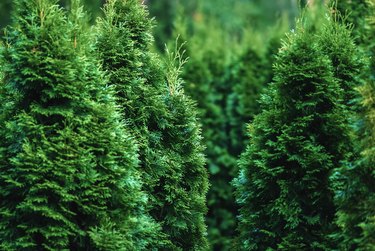
The four true Cedar trees (Cedrus spp.), thriving in U.S. Department of Agriculture plant hardiness zones 6 through 9, are harmless to dogs. The same isn't true for the white cedar (Melia azedarach), also known as the bead or chinaberry tree. White cedar is one of more than 700 plants containing pooch-toxic compounds, according to the Humane Society of the United States. White cedar has also invaded much of its growing range in USDA zones 7 through 10b.
White Cedar Toxins
Video of the Day
White cedar contains limonids classified as meliatoxins. They're most concentrated in the berries, but dogs can also ingest them by chewing the bark, leaves or flowers. The tree also contains a toxic alkaloid, three toxic resins and two toxic acids. These combined compounds add up to a very dangerous mouthful for your pet, causing symptoms anywhere from one hour to two days after he consumes them. Unless you get immediate help, he may go downhill rapidly. The good news is that white cedar berries are so bitter that most animals avoid them. The bad news is that eating just five or six of them has been fatal for small dogs.
Video of the Day
Signs of White Cedar Poisoning
White cedar poisoning affects a dog's digestive and nervous systems. He may experience vomiting, bloody diarrhea or constipation. Neurological symptoms include weakness, trembling, partial paralysis and collapse. Severe poisoning causes coma and respiratory failure. Unless treated, dogs ingesting lethal doses of white cedar toxins usually die within two days after their symptoms surface.
Saving Your Pet
If you find your dog nibbling on any part of the white cedar tree or showing symptoms of white cedar poisoning, get him to a veterinarian immediately. Treatments may include induced vomiting, pumping his stomach to remove the berries or other plant debris, giving him activated charcoal to absorb the toxins, or IV fluids to maintain his fluids and prevent kidney failure.
Why Your Dog Eats Plants
Your dog's plant-munching habit may be inherited. These pets occasionally eat grass or other plants to stimulate vomiting when they're sick. The majority of them, however, don't appear to be sick beforehand or vomit afterwards.
Researchers have speculated that Fido's wild ancestors consumed plants to clear parasites from their intestinal tracts. Even if parasite-free, modern dogs may be genetically wired to do the same.
Wild omnivorous canine ancestors are also believed to have filled dietary gaps by consuming plants and leaves. This is another behavior that has possibly been passed down to your pooch. Further, modern wild dogs have been observed consuming leaves and grasses, especially during times when their normal prey items may be scarce. Of course plants aren't nearly as canine nutritious as meat, but it's something to tide them over until the next good meal.
If your pet is determined to include vegetation in his diet, your only options are to keep your white cedar off limits to him or remove it from your yard. Focused training may work well for some dogs. For others, exclusionary tactics may be necessary to keep your dog from eating materials of white cedar origin.